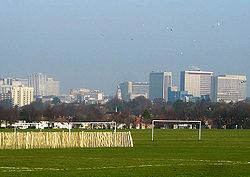Croydon
| Croydon | |
| Surrey | |
|---|---|
 Croydon town centre skyline, seen from the Colonnades | |
| Location | |
| Grid reference: | TQ335655 |
| Location: | 51°22’22"N, 0°6’36"W |
| Data | |
| Population: | 14,085 |
| Post town: | Croydon |
| Postcode: | CR0 |
| Dialling code: | 020 |
| Local Government | |
| Council: | Croydon |
| Parliamentary constituency: |
Croydon Central Croydon North Croydon South |
Croydon is a town in Surrey, found within the metropolitan conurbation. The area is identified in the “London Plan” as one of its region’s 11 “metropolitan centres”.[1]
Croydon sits on the natural transport corridor between London and Great Britain's south coast, just to the north of two gaps in the North Downs, through one of which runs the A23 Brighton Road from Purley to Merstham and through the other the A22 from Purley to the M25 Godstone interchange.
Name of the town
As the vast majority of place-names in the area are of Anglo-Saxon origin, the most likely theory is that the name Croydon derives originally from the Old English words croh and denu (“crocus valley”), suggesting that, like Saffron Walden in Essex, it was a centre for the collection of saffron.[2]
An alternative if less probable theory for the origin of the name was put forward by John Corbett Anderson,[3] who observed that:
"The earliest mention of Croydon is in the joint will of Beorhtric and Aelfswith, dated about the year 962. In this Anglo-Saxon document the name is spelt (here he uses original script) Crogdæne. Crog was, and still is, the Norse or Danish word for crooked, which is expressed in Anglo-Saxon by crumb, a totally different word. From the Danish came our crook and crooked. This term accurately describes the locality; it is a crooked or winding valley; in reference to the valley that runs in an oblique and serpentine course from Godstone to Croydon."
Anderson refuted a claim, originally cited by Andrew Coltee Ducarel, that the name came from the Old French for 'chalk hill', because the name was in use at least a century before the French language would have been commonly used following the Norman Invasion. However, why a Danish word would be used so far from the lands influenced by the Danes he did not explain.
History
At the time of the Domesday survey of 1086, Croydon had a church, a mill and around 365 inhabitants. Croydon expanded during the Middle Ages as a market town and a centre for charcoal production, leather tanning and brewing.
The Surrey Iron Railway from Croydon to Wandsworth opened in 1803 principally for the carriage of good from the factories of the Wandle valley to the coast, but it took paying passengers too. Indeed, the railway company ran no services itself, merely charging a toll to those who wished to place a carriage on the rails. Thus the Surrey Iron Railway was the world's first public railway. The carriages were horse-drawn, though in time the railway was converted for steam engines, and this railway developed into an important means of transport, facilitating Croydon's growth as a commuter town for the City of London and beyond.
In the early 20th century, Croydon was an important industrial area, known for metal working, car manufacture and its airport, which caused a growth of the metropolitan conurbation so as to swallow Croydon within it. In the mid 20th century the manufacturing industry was replaced by a retailing and service economy, show by a massive redevelopment which saw the rise of office blocks and the Whitgift shopping centre.
Road traffic is now diverted away from a largely pedestrianised town centre, but its main railway station, East Croydon, is still a major hub within the national railway transport system.
References
- ↑ Mayor of London (February 2008). "London Plan (Consolidated with Alterations since 2004)". Greater London Authority. http://www.london.gov.uk/thelondonplan/docs/londonplan08.pdf.
- ↑ Ayto, John; Ian Crofton (2005). Brewer's Britain and Ireland. Weidenfeld & Nicolson. ISBN 0-304-35385-X.
- ↑ Corbett Anderson, John; Ian Crofton (1882). A Short Chronicle Concerning the Parish of Croydon. London: Reeves and Turner. pp. 19–20. ISBN 0-304-35385-X. Republished in 1970 by SR Publishers, East Ardsley, Wakefield